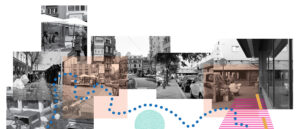Public Interiority

Public Interiority idea journal diagram presented in Bucharest, Romania.
These concepts are analyzed in Public Interiority: Exploring Interiors in the Public Realm (Routledge, 2024) through political contexts, psychological states, virtual spaces, atmospheric qualities, and virtual and built forms. This book was awarded the 2025 Interior Design Educators Council Book Award and originated from the 2023 Public Interiority Symposium hosted by the UT College of Architecture and Design. In addition to writing, Teston explores the climatic and experiential aspects of public interiority through installations, case studies, drawings, and making. A 2023 installation at the European Cultural Center in Venice considered material and light as atmospheric spatial generators. This global yet site-specific approach appears in published case studies on Bucharest, Knoxville, Las Vegas, London, New York, and Rome.
When we experience outside urban places as if they are interiors, we experience public interiority, blending our lived experiences with intersectional theories on interiors, urbanity, and society. This idea prioritizes the interior’s primary features.
Public interiority can be understood as places (interior, exterior, or in between) that enrich inhabitants’ interactions and lived experience. Intimacy and temporality inform how ambiance, perception, and usage can shape public space.
Psychologies of public interiority expand upon the characteristics of human perception and emotion. It considers the relationship between interiority and perception by beginning at the scale of the body, expanding into the near built environment, and continuing into the city as a whole. By fusing psychologies and body-space interactions, we understand interiority as a psychological condition, not just a space inside a building. Sympathetic interactions and energies between two people (or between a person and the environment) generate public interiority. These relational forces encounter and shape our perception of “inside-feeling” places. Psychological public interiorities are one part formal, one part perceptive.
Forms of public interiority study building characteristics that contribute to interiority in the public realm, amongst urban morphology, geography, and interior architectural theory. Form-based interiorities are not merely loosely arranged voids and surfaces. To experience an interior, we must perceive an internal spatial volume. Are we experiencing interiority when on a city sidewalk, sitting under an overhang? Or when walking between a snow berm and a building façade?
Atmospheres of interiority address various spectacles, ambiances, and impermanent conditions that produce transient forms of public interiority. Understanding the conception of the interior as a contingent situation, this work interprets phenomenological experiences and contextualizes meteorological forms of interiority. It tests ways that experiences, energies, atmospheres, microclimates, and senses demarcate interiority in the urban outdoors.
Public exteriors rely on usage and program to define interiority. What activities regularly occur only in the interior? If these uses move to the exterior, does the exterior realm automatically become a condition of public interiority, or does it need additional ingredients like obscured views, acoustic regulation, and shading devices to fulfil this classification? Activities like sleeping, toilet use, and intimacy are socially acceptable in private interiors. Other interior-typical activities frequently occur indoors but are socially acceptable outside—cooking, studying, watching TV, reading, working, or playing.
The politics of design in public interiority considers any type of societal institution that enacts rules or encourages specific ways of being in groups and individuals- any policy, network, association, or mode of production. These political acts involving design operate at the periphery of our ordinary conception of interiors and interiority. While the limits of politics forever unfold, public interiority is bounded by lived experience and place. This work is oriented toward the everyday human condition, sustainability, and the need for safe, healthy spaces in urban exterior-interior settings.
